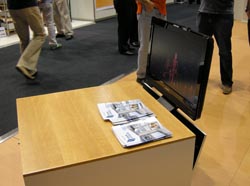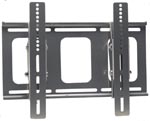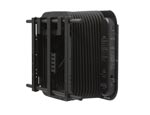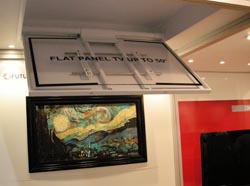A “tilt down” mount for large panels along with a “faux frame” that lifts the “art” up into the frame so that the panel is revealed.Peanut butter and jelly, Fourth of July and fireworks, iTunes and an iPod, baseball games and hot dogs. Some things not only go together, but once you think of one you are automatically drawn to the other as if to say that they are almost inseparable. Thus, while flat panel displays can, and often are attached to a wall, ceiling, or other structural element, panels and mounts are indeed something that you (and your clients) will likely think of as something that always go hand in hand.
Keeping with that mantra, it seems like a good idea to keep them linked together, particularly given that advances in one category often drives changes and advances in the other.
In the “good old days” things were simpler: today’s broader category of “video displays” were called “TV sets”. Due to the bulk, particularly in front-to-back depth, of CRT-based products, just about all you could do was to either build a box around them, as was traditional for rows and stacks of information displays in transportation terminals, or attach a mount that was basically a shelf, and tilt the set down towards its intended audience. Flat panel LCD and plasma displays have, of course changed that. Their thin front-to-back depth has given your designers and the architects they work with an entirely new range of opportunities.

Combining imagination and hefty dose of designer ingenuity, Ultralift Australia has built a lift into the bottom of a coffee table that could as easily be placed under a conference table.For example, as digital flat panels in the 22-inch-wide to 37-inch-wide range replace older CRT sets, hotels will replace the furniture that has traditionally held a TV, such as large armoires. Meanwhile, they certainly won’t want to just plop an expensive new LCD set on the dresser where it can easily be stolen. For that type of application, more than a simple wall mount will be required. Think about the swivels many TV sets are mounted on in lodging applications, and you have an opportunity to “up sell” to a two-arm mount that allows the flat panel to sit close to the wall, or swing out and swivel around.
Most of the major players have mounts that can do these tricks, but here’s where you can begin to get selective and look for products that include additional anti-theft features such as locks or specialized screws. Don’t presume that just because the set is mounted that clever thieves won’t simply unscrew it. Another important installation consideration when displays are on movable mounts, make certain that your mount is set up in such a way that prevents the set from hitting the wall, damaging both the display and the wall. Some mounts anticipate this by including bumpers, if not, you can add them yourself.
On the other hand, in some hospitality applications, either financial or aesthetic considerations require that the existing cabinets stay in place, even though the TV set or video display will be replaced. In those cases, you can make lemonade (and money) from what would otherwise seem to be a potential lemon. Sanus, among others, comes to the rescue with pull-out mounts that let the set recede into the cabinet, be easily pulled straight out, and then swiveled up to thirty degrees. This lets them have their “flat panel cake” and their “existing furniture”, too!
Inside Job
The whole notion of flat panel displays, regardless of screen size or technology, often requires that the display be mounted as close to the wall as possible. Fine, and very do-able, but keep in mind that the panels need some amount of “breathing room” for proper ventilation, so be certain to both plan and select the mount accordingly. Where an absolutely flat and flush to the wall installation is required, don’t just concentrate on the mounting apparatus, but expand your vision by looking at the many brands that offer in-wall mounting boxes that provide stability for the set but allow it to go inside the wall.
Of course, one way to mount things flat to the wall is to take advantage of the new trend in panels that are 1.5-inches thick. Soon even that dimension will be diminished to a thinner profile. This will be a hot new trend for high-end consumer applications, and while depth is not always as critical in commercial installations, these new panels are something that you’ll be called upon to hang sooner or later.
This great new display technology creates new opportunities, but if you pair it with a standard wall mount you’ll lose the benefit for which the set itself was specified. Rising to this challenge, mount manufacturers have begun to engineer and release products that allow you to convey the practically flat-to-the wall message of the display technology to a client with easy-to-visualize messaging, such as Chief’s claim that “the back of the panel is no more than a penny’s width from the wall.”
Consumer Behavior
If ultra-thins are one product you can take from the consumer installation handbook, another is to hide the display, rather than mount it in the wall or behind cabinet doors. Have at least one vendor in your portfolio that offers the “picture frame with retractable art”, with the art retracting to unveil the panel when the system powers on.
Yet one more consumer-world product category you shouldn’t ignore will be the sets that don’t require a mount at all, but rather are designed from the get-go for under-counter or below-shelf mounting in carrels and similar applications. Long available from many of the major brands in the hey-day of CRT sets, they have been slower to appear in small-size flat panels. Among the first of these is a 16-inch-wide model from Westinghouse that can be mounted either flat on a surface, or by switching the bezel and screen orientation in the menus, the base becomes a mount. Keep a watch on this configuration, as we expect more of this kind of set to become available as the rush to replace analog sets with flat panel digital ones accelerates into early 2009.
Alternatively, don’t ignore the use of “flip-down” mounts for under-counter use. OmniMount and others offer these in a variety of configurations. Of course, when planning to install this sort of mount, it goes without saying that you need to make certain that the millwork is substantial enough to hold the combined weight of both the mount and the panel, along with the extra stress that will come from someone pulling on it.
Here, look to the panel, as well as the mount, as you’ll increasingly want to supply HD-capable and 16:9 aspect ratio displays for smaller screen applications. That is not as much a problem with data/computer monitors, but finding a widescreen set with built-in tuner under the 19-inch size is still somewhat of a challenge. Resist the urge to put a computer monitor into play here when more consumer-esque sources are to be viewed. Though computer monitors may have DVI connectivity that you can convert to HDMI, that does not guarantee that the product is also equipped to handle sources protected with HDCP. In that scenario, you will connect a Blu-ray player or anything with protected content and your viewers will get high-definition nothing!
Razzle-Dazzle
When it comes to flat panel mounts, the glamourous part of business comes in two flavors. The first is when you need to build a veritable monitor tree—or forest—with four, six, twelve, or more displays fitting together to form a horizon of data for command/control systems, trading floors, transportation terminals, and similar applications. Here, the best suggestion is to work with your supplier of choice and see if there is anything that works off the shelf, or if something needs to be custom-built.
Of course, the ultimate is when things get motorized. Here, there are many options from a wide variety of suppliers. When specifying the more standard on-wall motorized mounts, check for the obvious things such as weight versus the load-bearing capacity of the surface they’ll be mounted to, compatibility as needed with any integrated system controller, the extension from the wall, even when the panel is fully retracted, and how good a job the system’s designers have done in masking off the mechanical system with a bellows or similar.
But we’ve left the best for last. The real fun in specifying and installing panels and mounts comes when you design an application where the panel is on a motorized mount that not only moves it around, but moves it out of sight. To some extent, this is an extension of the systems sold over the years that have hidden CRT sets in cabinetry at the foot of a bed (something seemingly destined for Las Vegas high-roller suites). That’s easy enough for you to offer, and there are projects where that will do the trick.
The thin depth of LCD and plasma displays has created a whole new category of products that, while glitzy, do make functional sense for boardrooms, conference centers and the like. Imagine describing to a prospect or client that at the touch of a button the flat panel screen they otherwise didn’t want to see will tilt down out of the ceiling. This is particularly useful for locations where there is no room above the ceiling to raise the panel straight up, though that remains an option, of course.
To close this month’s column, however, we leave you with a concept for which we saw a working prototype in late July at the CEDIA Asia/Pacific Expo 2008 in Australia. Combining imagination and hefty dose of designer ingenuity, Ultralift Australia, which also makes most of the types of mounts mentioned here, built a lift into the bottom of a coffee table that could as easily be placed under a conference table, though perhaps at the expense of leg room.
Push a button, a panel tilts down, and with mechanical wonderment that equals the first time you saw an old Ford Skyliner’s roof retract, or for those who are younger, the way the solid roof on any number of sports cars magically drops into the trunk, the panel tilts out, unfolds its mount, and ends up at a solid 90-degree angle to the table top. Push the button again and in less than a minute the panel disappears. It’s sort of against the rules to let a product like this dictate design for an application, but if you see this mount in action, you’ll want to place one, as well.
Mounts and panels, panels and mounts. As the song says about love and marriage, they go together like a horse and carriage. You definitely “...can’t have one without the other!” But, just as you need to have just the right mate to make the marriage work, and you need the right horse to match to the carriage, don’t just plop a screen on a mount—pick the right combination and your business will take you on the road to profit.
New Mount Products 2008
Video Mount Products LCD-MID-FT
The Video Mount Products LCD-MID-FT universal mid-size flat panel flush wall mount with tilt capabilities is a mounting solution for 27- to 42-inch plasma and LCD monitors. Whether for residential or commercial applications where durability, flexibility, and aesthetics are major concerns, the LCD-MID-FT includes many benefits for mounting mid-size flat panels. The unit has been designed for a shallow 2.4-inch wall-to-monitor profile for installs with either space constraint situations or where the customer simply wants the flat panel to be as flush to the wall as possible.
Chief Fusion
Chief's new Fusion low-profile, universal mounting system focuses on usability and speed of installation. The new design, available in fixed or tilt models for 26- to 75-inch TVs, was engineered to solve the most common installation problems to free valuable installation time. Features include centerless lateral shift, offering up to 16 inches of post-installation lateral shift, so users can offset the mount from the studs. ControlZone leveling allows post-installation fine-tuning of height and leveling by using an Allen key so it is easy to make adjustments after the mount is already on the wall.
Premier Mounts PWH Series Cable Management Accessory
Based on input from system integrators and its dealer network, Premier Mounts has introduced the PWH Series of cable management accessories for its PDS Series projector mount. Ideally suited for education and commercial applications where appearance and security are paramount, the PWH Series minimizes the visibility of cords and plugs to present a unified and professional mount-to-projector solution. An adaptation of Premier's line of pre-cut pipes, the PWH Series incorporates a cutout hole so that cables and electrical wiring can be run within the pipe.
Da-Lite PWM-AR1
The PWM-AR1 articulating flat panel wall mount has been added to Da-Lite’s Advance line of mount products. Equipped with an articulating arm, the mount can extend a flat panel monitor up to 29 inches away from the wall. The PWM-AR1 is designed with a unique rail mounting system to make installation simple for any plasma with mounting holes 1.5 to 62 inches apart horizontally and up to 20.5 inches apart vertically. The mount will hold up to 130 pounds and features 20 degrees of tilt. The PWM-AR1 is finished with a black or gray powder coated finish.




OmniMount Tria Series
OmniMount now manufactures three entry-level component and cable management solutions to make up the Tria Series. Modular in design and created to work together with other Tria units, the Tria Series offers a hassle-free shelving and cable management solution suitable for any environment. The Tria Series is ideal for do-it-yourself installers and allows users to neatly organize components right underneath a flat panel without the need to run cable connections through the wall. The Tria Series feature shelves made of 6mm tempered glass that can be adjusted in 1-inch increments.
Ultralift Phoenix Lift
Ultralift Australia's Phoenix gives you unlimited applications for a plasma screen. The compact design allows users to hide your television into sideboards and cabinets providing the ultimate in style, security, and protection. Ultralift Australia's Phoenix lift incorporates super smooth, quiet operation and compact design. Available in sizes to suit plasma and LCD screens up to 42-inches. Includes universal screen mount, complete with all fixing hardware, IR kit, and remote control.
Draper's Reveal/Conceal FlatScreen Lifts
Draper's new FlatScreen Display Lifts are designed to raise a plasma or LCD flatscreen display out of a custom cabinet or furniture. The stored dimensions are significantly more compact, and yet the maximum extended height is greater than any other model currently available. In addition, the interior dimensions of the cabinet only need to exceed the height of the stored lift by two inches. Draper's FlatScreen Lifts offer more flexibility for the installer or furniture manufacturer.
Peerless Slimline Ultra-Thin Mounts
The new Slimline Ultra-Thin Universal Mounts deliver a virtually no-profile installation that positions flat panel screens a mere 0.4 inches from the wall, and are so thin that they virtually disappear behind the screen. The mount's ultra-thin profile complements Hitachi's 1.5 inch ultra-thin TVs, but its universal design enables the Slimline mounts to accommodate any new ultra-slim TV on the horizon. And with up to 150-pound UL-tested load capacity, the Slimline mounts can even handle the weights of standard flat panel LCD and plasma TVs on the market today.

